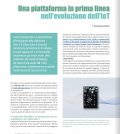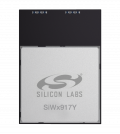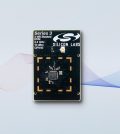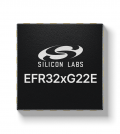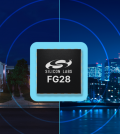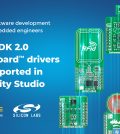Microcontrollers – Answers provided by Shahram Tadayon, field marketing manager, Silicon Labs
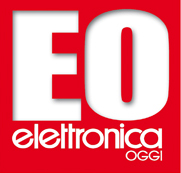
Dalla rivista:
Elettronica Oggi

Q: What are your opinions regarding the major trends for this market (slowing, growing, booming…)
A: The need for ultra-low power: Ongoing market demand for ultra-low-power MCUs is driven by the proliferation of power-sensitive portable/handheld and battery-powered products. Leading MCU vendors recognize the importance of low-power technology, and the development of an ultra-low-power benchmark by EEMBC this year will give developers a new objective yardstick for assessing the real-world energy efficiency of MCU products. MCU suppliers will continue to introduce MCU products and software tools that help developers optimize their designs for the lowest system-level power.
Differentiation through peripheral integration in 32-bit MCUs: With ARM technology becoming a de-facto standard, 32-bit MCU product differentiation no longer centers on the core architecture. The value in MCUs stems from integration of analog/mixed-signal peripherals, architectural innovations that enhance ease of configuration, and the development tools that MCU suppliers provide to make the engineer’s job easier. We believe that these 32-bit market dynamics favor the market success of ARM-based MCUs that feature a high level of peripheral integration and innovations such as crossbar architectures that enable developers to optimize their peripheral pinouts for specific applications.
The resilience of 8-bit and the decline of 16-bit: Proprietary architectures dominate the 16-bit world while the popular 8051 core is widely used in 8-bit designs, and ARM is now the prevailing technology for 32-bit MCUs. As embedded developers migrate to standardized cores, the 16-bit market is getting squeezed between the stable 8-bit market and the burgeoning 32-bit market. As a result, 32-bit and 8-bit designs will continue to gain traction over 16-bit. We are also continuing to see strong customer demand for 8-bit MCUs for many basic embedded applications that simply “toggle bits” and thus do not require 32-bit processing horsepower and large amounts of memory. For example, an 8-bit MCU is ideal for a simple wireless glass-break detection sensor in the home. In addition, 8-bit MCUs lend themselves to very small form factors, making them a good choice for space-limited designs.
Q: What are the key strategies adopted by your company in the short/medium period to address (or to better address) the needs of the market?
A: To address the need for energy efficiency, Silicon Labs continues to provide MCU solutions designed to minimize system-level power. For example, our SiM3L1xx Precision32 MCUs offer features such as an on-chip dc-to-dc converter and dynamic voltage scaling that enable these ultra-low-power 32-bit devices to reduce power consumption to 175 µA/MHz in active mode and less than 250 nA in sleep mode with the real-time clock enabled, full memory retention and a 4 µs wake time.
We believe it is no longer enough for MCU vendors to provide low-power MCUs. Our strategy is to provide “power-aware” software tools that enable developers to minimize system-level power. For example, Silicon Labs’ Eclipse-based IDE features tools that estimate power consumption and provide configuration guidance to reduce power. These tools include Power Estimator, which provides a graphical representation of the total supply current and additive currents for enabled peripherals. Raw current values of each peripheral show where power is being consumed, and a pie chart shows the percentage of each peripheral’s power usage relative to the total current. A second tool, Power Tips, provides software configuration guidance that helps developers minimize current consumption. Being able to see power optimization tips during MCU configuration saves considerable development time.
Q: What are you doing in order to implement your strategies (partnership/agreements, new acquisitions, investments in activities like R&D, people….)
A: Silicon Labs invests significantly in a wide range of R&D activities including the development of mixed-signal technologies that minimize chip-level and system-level power. We continue to hire some of the best engineering talent in the industry to push the edge of low-power chip design and develop power-optimization technology at the software level. We also collaborate with a variety of software and systems providers to develop comprehensive solutions for power-sensitive designs and green energy applications such as wireless sensor networks, smart meters and solar microinverters.
Q: And in the middle/long term (if you have a crystal ball!)?
A: The most exciting mid/long-term opportunity is the rapid emergence of the Internet of Things (IoT). New generations of connected devices for the IoT will enable people everywhere to remotely control and monitor the energy consumption in their homes and to remotely control their lighting and security systems, among many other quality-of-life activities. Ultra-low-power wireless system-on-chip (SoC) solutions and robust, easy-to-deploy software are key enablers of IoT applications. As a leading supplier of energy-efficient MCU and wireless solutions for IoT applications, Silicon Labs will continue to advance the state of the art in ultra-low-power wireless SoC design. Our EM35x Ember ZigBee solutions – the industry’s first ZigBee SoCs based on ARM technology and the most widely used ZigBee platform for mesh networking applications – will continue to gain traction in the IoT market. We will also continue to expand our EM35x SoC portfolio and our field-proven EmberZNet PRO mesh networking protocol stack to address emerging market needs.
Edited by the editorial staff
Contenuti correlati
-
Una piattaforma in prima linea nell’evoluzione dell’IoT
I livelli di produttività e le caratteristiche all’avanguardia della piattaforma Serie 3 di Silicon Labs di prossima introduzione permetteranno lo sviluppo di nuove applicazioni e di funzionalità innovative nei più diversi settori, dalla produzione alla vendita al...
-
Una guida pratica e dettagliata allo sviluppo di dispositivi Matter per l’automazione delle smart home
Non c’è dubbio che Matter si stia rivelando un mezzo molto efficace per collegare le piattaforme di automazione domestica di diversi fornitori, riducendo l’attuale frammentazione tra i vari costruttori di dispositivi IoT. Consentendo ai protocolli wireless esistenti,...
-
I nuovi moduli Wi-Fi 6 e Bluetooth LE 5.4 di Silicon Labs
Silicon Labs ha comunicato la disponibilità dei moduli SiWx917Y Wi-Fi 6 e Bluetooth Low Energy (LE) 5.4 a bassissimo consumo. Questi dispositivi sono caratterizzati da un’elevata efficienza energetica, una connettività wireless affidabile, prevedono funzionalità di sicurezza avanzate...
-
La piattaforma Serie 3 di Silicon Labs
Il CEO di Silicon Labs, Matt Johnson, e il CTO Daniel Cooley hanno delineato, in occasione del keynote di apertura della manifestazione embedded world North America, il ruolo dell’AI nell’evoluzione del mondo IoT e hanno fornito le...
-
I Soc wireless di Silicon Labs con funzionalità di energy harvesting
Silicon Labs ha realizzato la nuova famiglia di SoC wireless xG22E, espressamente concepita per operare con consumi ridottissimi, come richiesto dalle applicazioni di energy harvesting che non prevedono l’uso di batterie. La nuova linea è composta dai...
-
Matter: un protocollo sempre più accessibile grazie alla collaborazione tra Arduino e Silicon Labs
Arduino e Silicon Labs (NASDAQ: SLAB) hanno recentemente annunciato un nuovo accordo di collaborazione il cui obiettivo è rivoluzionare l’accesso a Matter, il protocollo di connettività open source promosso da CSA (Connectivity Standard Alliance). Si tratta di...
-
SoC wireless per dispositivi medicali connessi
La famiglia di dispositivi wireless sicuri e a basso consumo di Silicon Labs, come quelli della serie BG27, grazie alle loro caratteristiche rappresentano la soluzione ideale per applicazioni IoMT (Internet of Medical Things) Leggi l’articolo completo su...
-
Partnership tra Silicon Labs e Arduino
Silicon Labs ha annunciato di aver siglato un nuovo accordo di collaborazione con Arduino, con l’obiettivo di semplificare lo sviluppo di applicazioni Matter over Thread per la community di Arduino. Realizzate in collaborazione con Silicon Labs, le...
-
Silicon Labs ha presentato il SoC dual band FG28 con AI
Il nuovo SoC dual-band FG28 di Silicon Labs è stato progettato per reti e protocolli a lungo raggio come Amazon Sidewalk, Wi-SUN e altri protocolli proprietari. Si tratta di un componente che integra le interfacce radio sub-Gigahertz...
-
Silicon Labs supporta il driver della Click Board MIKROE mikroSDK 2.0
MikroElektronika (MIKROE) ha annunciato che Silicon Labs è il primo produttore a supportare i driver mikroSDK 2.0 Click grazie all’aggiunta di un’estensione hardware per il driver (plugin) a MIKROE Gecko SDK, ora disponibile nell’ambiente di sviluppo integrato...


